Fundamentals of Biochemistry
Written exam of 1:30 h (no documents, no electronic calculator)
This course describes the fundamental molecular processes that take place in living cells. We shall describe the structure and function of the major biological macromolecules. The flux of information in the cells and the evolution principles will be discussed. Non-covalent interactions; Proteins: structure and function; Enzymology: fundamental enzyme properties and applications; Nucleic acids: structure and function; replication; transcription, translation; Carbohydrates: structure, reactivity, and function; Lipids and biological membranes.
After attending this course, the student should know the main non-covalent interactions that are important in life sciences: electrostatic, Van der Waals, hydrogen bonds, hydrophobic interactions.
The student should be able to describe the primary, secondary, tertiary and quaternary structure of proteins as well as defining the native structure and its main properties.
The student should be able to describe Michaelis-Menten enzyme kinetics, explain how enzyme works (catalysis type, reaction mechanism of typical proteases) and to understand the effect of reversible competitive inhibitors on enzymes and of covalent inhibitors.
The student should be able to describe the structure of nucleic acids (DNA and RNA) and the mechanism of the flux of information transfer in the cell (replication, transcription, translation), and the synthesis of deoxy-oligonucleotides, a PCR experiment, and the DNA sequencing by the Sanger method.
The student should be able to describe the structure of hexoses and ketoses (from three carbons to six carbons; Fischer projection, Haworth representation and chair conformation), to know their reactivity (cyclization, mutarotation, isomerization)
The student should be able to describe the structure of simple lipids and of their main components (fatty acids, triglycerides, phospholipids) and to describe the structure of the bilayer membrane and the main functions of the biological membranes.
Teaching language: FR
Documents:
pdf document of the slide presentation
